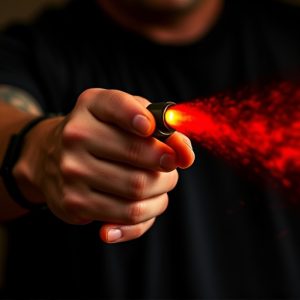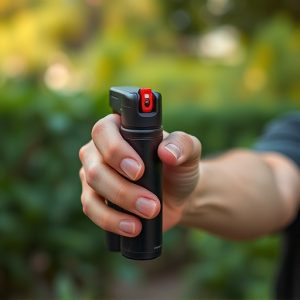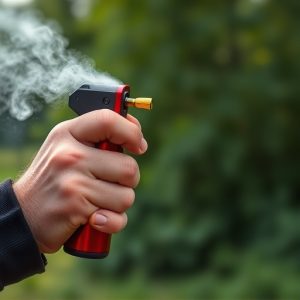Low Light Pepper Spray: Tactics, Science, Safety, & Global Implications
Low light pepper spray tactics have emerged as a crucial tool for law enforcement in managing chaoti…….
Low light pepper spray tactics have emerged as a crucial tool for law enforcement in managing chaotic situations, particularly in low-visibility environments. This innovative product incapacitates individuals without permanent harm, acting on capsaicin to create an intense inflammatory response in the eyes, nose, and respiratory system. Effective deployment strategies require specialized equipment, training, and de-escalation techniques to minimize damage and officer safety. While globally adopted for riot control, its use is governed by complex legal landscapes due to human rights concerns.
In the realm of riot control, low light pepper spray tactics have emerged as a specialized tool for law enforcement. This article delves into the science behind this inflammatory spray, its strategic deployment in challenging scenarios, and safety considerations crucial for officers’ training. We explore global perspectives on its use and legal implications, providing insights into how these tactical sprays enhance control measures while adhering to strict protocols. Understanding low light pepper spray’s unique capabilities is essential for effective riot management.
- Understanding Low Light Pepper Spray: A Special Tactical Tool
- The Science Behind its Inflammatory Effects
- Effective Deployment Strategies in Riot Control Scenarios
- Safety Considerations and Training for Law Enforcement Officers
- Global Perspectives on Its Use and Legal Implications
Understanding Low Light Pepper Spray: A Special Tactical Tool
Low light pepper spray tactics have become an integral part of law enforcement and security protocols, offering a specialized tool for managing chaotic situations. This innovative product is designed to counteract the challenges posed by low-visibility environments, where traditional methods may be less effective. Its tactical application lies in its ability to quickly incapacitate individuals without causing permanent harm, making it a game-changer during riots or high-stress incidents.
The unique feature of low light pepper spray is its formulation and delivery system. Unlike regular pepper spray, which relies on direct contact with the eyes and respiratory system, this variant is optimized for diffusion in dimly lit areas. It utilizes specialized caps and nozzles to project a fine mist, ensuring maximum coverage even in narrow spaces. This strategic application disrupts visual clarity and breathing, temporarily neutralizing participants in riots or violent gatherings. With its non-lethal properties, it provides an effective solution for crowd control while minimizing the risk of further escalation.
The Science Behind its Inflammatory Effects
The science behind inflammatory spray for riot control, often referred to as low light pepper spray tactics, is grounded in a complex interplay of chemicals and physiological responses. These sprays typically contain capsaicin, the active ingredient found in chili peppers, which irritates the eyes, nose, and respiratory system. When deployed, the spray creates a temporary but intense inflammatory response, leading to irritation and discomfort that can quickly disrupt and disperse crowds.
The effectiveness of these tactics lies in their ability to induce rapid sensitivity and pain, enabling law enforcement to manage high-stress, low light scenarios more effectively. The capsaicin binds to specific receptors in the body, triggering a cascade of events that result in inflammation and subsequent numbing. This reaction is designed to provide enough time for order to be restored without escalating violence or endangering public safety.
Effective Deployment Strategies in Riot Control Scenarios
In riot control scenarios, effective deployment strategies are crucial for minimizing damage and ensuring officer safety. One powerful tool in law enforcement’s arsenal is low light pepper spray, which can be incredibly effective when used tactically. By utilizing specialized equipment designed for low-light conditions, such as night vision goggles, officers can deploy the spray with precision, targeting specific individuals while limiting its impact on bystanders. This involves careful assessment of the crowd, identifying leaders or agitators, and aiming for their faces to maximize the effect.
Low light pepper spray tactics require training and practice to execute successfully. Officers should be taught to use cover and concealment to protect themselves, as well as techniques for quick deployment in chaotic environments. Timing is critical; deploying at the right moment can disrupt crowd dynamics without causing widespread panic or injury. Additionally, ensuring proper ventilation is vital to minimize the concentration of irritants, especially in enclosed spaces.
Safety Considerations and Training for Law Enforcement Officers
When employing inflammatory spray, or pepper spray, for riot control, safety considerations are paramount. Law enforcement officers must be adequately trained in its correct usage to minimize risks and ensure effectiveness. Training should cover proper application techniques, especially in low light conditions, as this is when rioters often operate. Officers need to understand the spray’s range, duration, and potential side effects to make informed decisions during high-pressure situations.
Regular practice sessions can help officers develop proficiency in low light pepper spray tactics. This includes learning how to aim, activate, and move while deploying the spray to disrupt rioters’ formations and vision. Effective training also equips officers with knowledge about de-escalation strategies, enabling them to manage conflicts without resorting to force unnecessarily.
Global Perspectives on Its Use and Legal Implications
In many countries worldwide, low light pepper spray tactics have been adopted by law enforcement agencies as a tool for riot control and crowd management. This non-lethal weapon is seen as a less invasive alternative to firearms in high-stress situations. Global perspectives on its use vary; while some nations actively integrate it into their police protocols, others remain cautious due to concerns over human rights and potential misuse.
The legal implications surrounding inflammatory spray are complex. Many countries have stringent regulations governing its manufacture, sale, and deployment, with strict guidelines on the force that can be applied. Issues of consent, proportionality, and necessity are at the forefront of these discussions. As awareness of civil liberties and human rights increases, so does scrutiny over low light pepper spray tactics, requiring continuous evaluation and refinement of policies to ensure responsible and ethical use.
Low light pepper spray tactics have proven to be a valuable asset in riot control, offering a strategic advantage in challenging environments. By understanding its science, deployment methods, and safety protocols, law enforcement can maximize its effectiveness while mitigating potential risks. As global perspectives on its use continue to evolve, ongoing training and discussions around legal implications are essential to ensure responsible integration into law enforcement practices.


